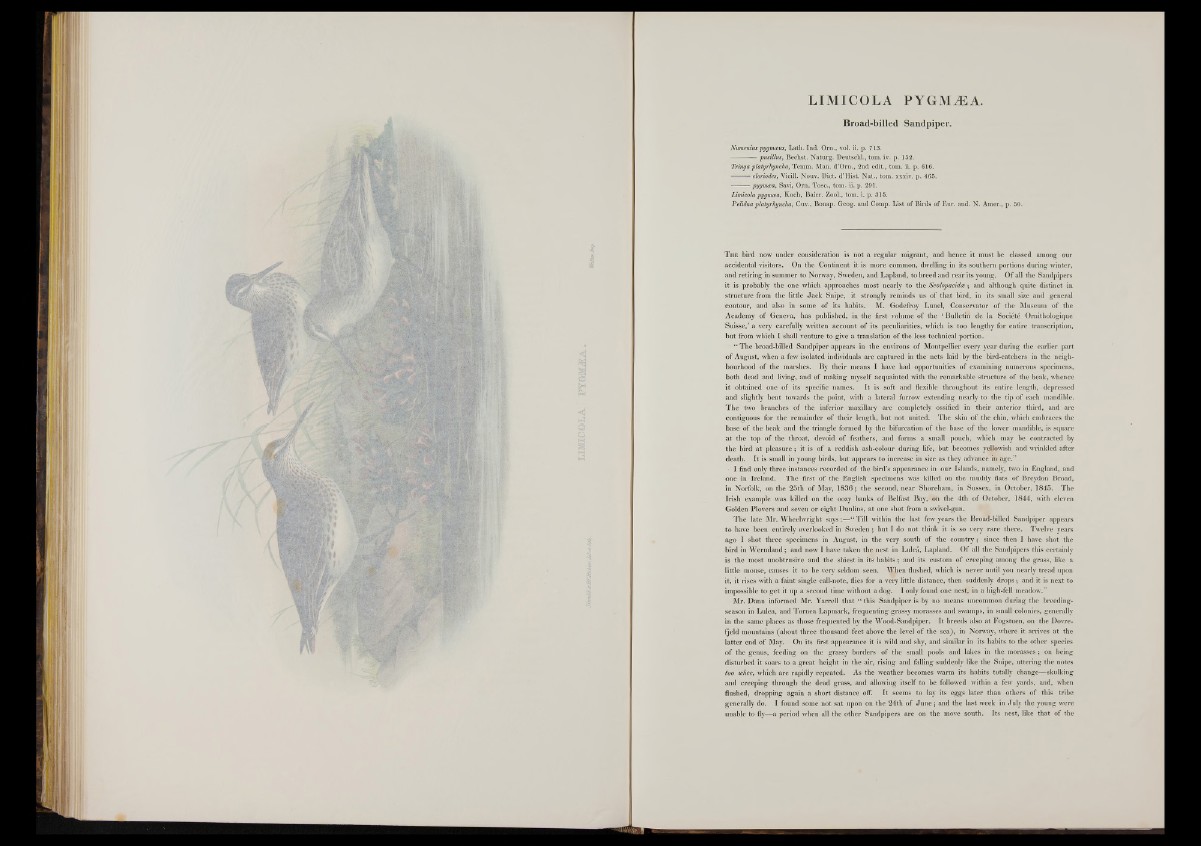
LIMICOLA PYGMÆA.
Broad-billed Sandpiper.
Numenius pygmaus, Lath. Ind. Orn., vol. ii. p. 713.
pusillus, Bechst. Naturg. Deutschl., tom. iv. p. 15*2.
Tringa platyrhyncha, Temm. Man. d’Orn., 2nd edit., tom. ii. p. 616.
eloriodes, Vieill. Nouv. Diet. d’Hist. Nat., tom. xxxiv. p. 465.
pygnuea, Savi, Orn. Tose., tom. ii. p. 291.
Limicola pygttusa, Koch, Baier. Zool., tom. i. p. 315.
Pelidna platyrhyncha, Cuv., Bonap. Geog. and Comp. List of Birds of Eur. and. N. Amer., p. 50.
T he bird now under consideration is not a regular migrant, and hence it must be classed among our
accidental visitors. On the Continent it is more common, dwelling in its southern portions during winter,
and retiring in summer to Norway, Sweden, and Lapland, to breed and rear its young. Of all the Sandpipers
it is probably the one which approaches most nearly to the Scolopacidoe ; and although quite distinct in
structure from the little Ja ck Snipe, it strongly reminds us of that bird, in its small size and general
contour, and also in some o f its habits. M. Godefroy Lunel, Conservator of the Museum o f the
Academy o f Geneva, has published, in the first volume of the ‘ Bulletin de la Société Ornithologique
Suisse,’ a very carefully written account o f its peculiarities, which is too lengthy for entire transcription,
but from which I shall venture to give a translation of the less technical portion.
“ The broad-billed Sandpiper appears in the environs of Montpellier every year during the earlier part
o f August, when a few isolated individuals are captured in the nets laid by the bird-catchers in the neighbourhood
of the marshes. By their means I have had opportunities o f examining numerous specimens,
both dead and living, and o f making myself acquainted with the remarkable structure of the beak, whence
it obtained one o f its specific names. It is soft and flexible throughout its entire length, depressed
and slightly bent towards the point, with a lateral furrow extending nearly to the tip of each mandible.
The two branches of the inferior maxillary are completely ossified in their anterior third, and are
contiguous for the remainder of their length, but not united. The skin of the chin, which embraces the
base o f the beak and the triangle formed by the bifurcation of the base of the lower mandible, is square
a t the top o f the throat, devoid of feathers, and forms a small pouch, which may be contracted by
the bird at pleasure ; it is of a reddish ash-colour during life, but becomes yellowish and wrinkled after
death. I t is small in young birds, but appears to increase in size as they advance in age.”
• I find only three instances recorded of the bird’s appearance in our Islands, namely, two in England, and
one in Ireland. The first o f the English specimens was killed on the muddy flats of Breydon Broad,
in Norfolk, on the 25th o f May, 1836 ; the second, near Shoreham, in Sussex, in October, 1845. The
Irish example was killed on the oozy banks o f Belfast Bay, on the 4th o f October, 1844, with eleven
Golden Plovers and seven o r eight Dunlins, at one shot from a swivel-gun.
The late Mr. Wheelwright says :—“ Till within the last few years the Broad-billed Sandpiper appears
to have been entirely overlooked in Sweden ; but I do not think it is so very rare there. Twelve years
ago I shot three specimens in August, in the very south o f the country ; since then I have shot the
bird in Wermland ; and now I have taken the nest in Luleâ, Lapland. O f all the Sandpipers this certainly
is the most unobtrusive and the shiest in its habits ; and its custom o f creeping among the grass, like a
little mouse, causes it to be very seldom seen. When flushed, which is never until you nearly tread upon
it, it rises with, a faint single call-note, flies for a very little distance, then suddenly drops ; and it is next to
impossible to get it up a second time without a dog. I only found one nest, in a high-fell meadow.”
Mr. Dann informed Mr. Yarrell that “ this Sandpiper is by no means uncommon during the breeding-
season in Lulea, and Tornea Lapmark, frequenting grassy morasses and swamps, in small colonies, generally
in the same places as those frequented by the Wood-Sandpiper. I t breeds also at Fogstuen, on the Dovre-
fjeld mountains (about three thousand feet above the level o f the sea), in Norway, where it arrives at the
latter end of May. On its first appearance it is wild and shy, and similar in its habits to the other species
o f the genus, feeding on the grassy borders of the small pools and lakes in the morasses ; on being
disturbed it soars to a great height in the air, rising and falling suddenly like the Snipe, uttering the notes
too whee, which are rapidly repeated. As the weather becomes warm its habits totally change—skulking
and creeping through the dead grass, and allowing itself to be followed within a few yards, and, when
flushed, dropping again a short distance off. It seems to lay its eggs later than others of this tribe
generally do. I found some not sat upon on the 24th of June ; and the last week in July the young were
unable to fly—a period when all the other Sandpipers are on the move south. Its nest, like that o f the